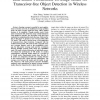Free Online Productivity Tools
i2Speak
i2Symbol
i2OCR
iTex2Img
iWeb2Print
iWeb2Shot
i2Type
iPdf2Split
iPdf2Merge
i2Bopomofo
i2Arabic
i2Style
i2Image
i2PDF
iLatex2Rtf
Sci2ools
77
Voted
ICDCS
2010
IEEE
2010
IEEE
Link-Centric Probabilistic Coverage Model for Transceiver-Free Object Detection in Wireless Networks
Abstract--Sensing coverage is essential for most applications in wireless networks. In traditional coverage problem study, the disk coverage model has been widely applied because of its simplicity. Though notable recent works point out that the disk model has many critical limitations when applied in practice, few successful works have been conducted to comprehensively study the issue. Motivated by this, in this paper we propose a new coverage model called T-R model. T-R model is derived from a real application of transceiver-free object detection. Compared with the traditional disk model, T-R model is able to describe many new coverage features such as the probabilistic coverage, the link-centric coverage units and the correlations between multiple coverage units. These new capabilities model a better abstraction of individual sensors. To evaluate the performance of T-R model, we conduct comprehensive empirical studies based on a test-bed of 30 telosB nodes. Experimental results show ...
Related Content
| Added | 09 Nov 2010 |
| Updated | 09 Nov 2010 |
| Type | Conference |
| Year | 2010 |
| Where | ICDCS |
| Authors | Dian Zhang, Yunhuai Liu, Lionel M. Ni |
Comments (0)

